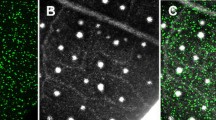Abstract
To understand how Citrus tristeza virus (CTV) replicates and moves inside the plant, it is critical to study the cellular interactions and localization of its encoded proteins. However, due to technical limitations, so far these studies have been limited to the nonnatural host Nicotiana benthamiana.
Particle bombardment is a physical method to deliver nucleic acid and other biomolecules into the cells directly. The Helios® gene gun (Bio-Rad, Hercules, CA) is a handheld device that uses a low-pressure helium pulse to accelerate high-density, subcellular-sized particles into a wide variety of targets for in vivo and in vitro applications. Here, we describe a detail protocol for either transient or stable gene expression in citrus leaf cells using this gene gun. This protocol can be used to study protein-protein interactions and subcellular localization in different kinds of plant cells.
Access this chapter
Tax calculation will be finalised at checkout
Purchases are for personal use only
Similar content being viewed by others
References
Dolja VV, Kreuze JF, Valkonen JPT (2006) Comparative and functional genomics of closteroviruses. Virus Res 117:38–51
Satyanarayana T, Gowda S, Ayllón MA et al (2003) Closterovirus bipolar virion: evidence for initiation of assembly by minor coat protein and its restriction to the genomic RNA5´ region. PNAS 101(3):799–804
Moreno P, Ambrós S, Albiach-Martí MR et al (2008) Citrus triseza virus: a pathogen that changed the course of the citrus industry. Mol Plant Pathol 9(2):251–268
Bak A, Folimonova SY (2015) The conundrum of a unique protein encoded by citrus tristeza virus that is dispensable for infection of most hosts yet shows characteristics of a viral movement protein. Virology 485:86–95
Kang S-H, Dao TNM, Kim O-K et al (2017) Self-interaction of Citrus tristeza virus p33 protein via N-terminal helix. Virus Res 233:29–34
Ruiz-Ruiz S, Soler N, Sánchez-Navarro J et al (2013) Citrus tristeza virus p23: determinants for nucleolar localization and their influence on suppression of RNA silencing and phatogenesis. Mol Plant-Microbe Interact 26(3):306–318
Klein TM, Wolf ED, Wu R et al (1987) High-velocity microprojectiles for delivering nucleic acids into living cells. Nature 327:70–73
Klein TM, Fromm M, Weissinger A et al (1988) Transfer of foreign genes into intact maize cells with high-velocity microprojectiles. Proc Natl Acad Sci U S A 85:4305–4309
McCabe DE, Swain WF, Martinell BJ et al (1988) Stable transformation of soy bean (Glycine max) by particle acceleration. Nat Biotechnol 6:923–926
Yang NS, Burkholder J, Roberts B et al (1990) In vivo and in vitro gene transfer to mammalian somatic cells by particle bombardment. Proc Natl Acad Sci U S A 87:9568–9572
Smith FD, Harpending PR, Sanford JC (1992) Biolistic transformation of prokaryotes: factors that affect biolistic transformation of very small cells. J Gen Microbiol 138:239–248
Armaleo D, Ye G-N, Klein TM et al (1990) Biolistic nuclear transformation of Saccharomyces cerevisiae and other fungi. Curr Genet 17:97–103
O’Brien JA, Lummis SCR (2009) Biolistic transfection of neuronal cultures using a hand-held gene gun. Nat Protoc 1(2):977–981
Belyantseva IA (2016) Helios® gene gun-mediated transfection of the inner ear sensory epithelium: recent updates. In: Sokolowski B (ed) Auditory and vestibular research, Methods in molecular biology, vol 1427. Humana Press, New York, NY
Carsono N, Yoshida T (2008) Transient expression of green florescent protein in rice calluses: optimization of parameters for Helios gene gun device. Plant Prod Sci 11:88–95
Kuriakose B, Du Toit ES, Jordaan A (2012) Transient gene expression assays in rose tissues using a bio-rad Helios® hand-held gene gun. S Afr J Bot 78:307–311
Ueki S, Magori S, Lacroix B et al (2013) Transient gene expression in epidermal cells of plant leaves by biolistic DNA delivery. Methods Mol Biol 940:17–26
Yamagishi N, Terauchi H, Kanematsu S et al (2006) Biolistic inoculation of soybean plants with soybean dwarf virus. J Virol Methods 137:164–167
Levy A, El Mochtar C, Wang C et al (2018) A new toolset for protein expression and subcellular localization studies in citrus and its application to Citrus tristeza virus proteins. Plant Methods 14:2
Acknowledgments
Support for this work was provided by the Specialty Crop Research Initiative (SCRI) Citrus Disease Research and Extension Program (CDRE) grant number P0066064 and by the Florida State legislative funding for the UF/IFAS Citrus Initiative.
Author information
Authors and Affiliations
Corresponding author
Editor information
Editors and Affiliations
Rights and permissions
Copyright information
© 2019 Springer Science+Business Media, LLC, part of Springer Nature
About this protocol
Cite this protocol
Acanda, Y., Wang, C., Levy, A. (2019). Gene Expression in Citrus Plant Cells Using Helios® Gene Gun System for Particle Bombardment. In: Catara, A., Bar-Joseph, M., Licciardello, G. (eds) Citrus Tristeza Virus. Methods in Molecular Biology, vol 2015. Humana, New York, NY. https://doi.org/10.1007/978-1-4939-9558-5_16
Download citation
DOI: https://doi.org/10.1007/978-1-4939-9558-5_16
Published:
Publisher Name: Humana, New York, NY
Print ISBN: 978-1-4939-9557-8
Online ISBN: 978-1-4939-9558-5
eBook Packages: Springer Protocols




